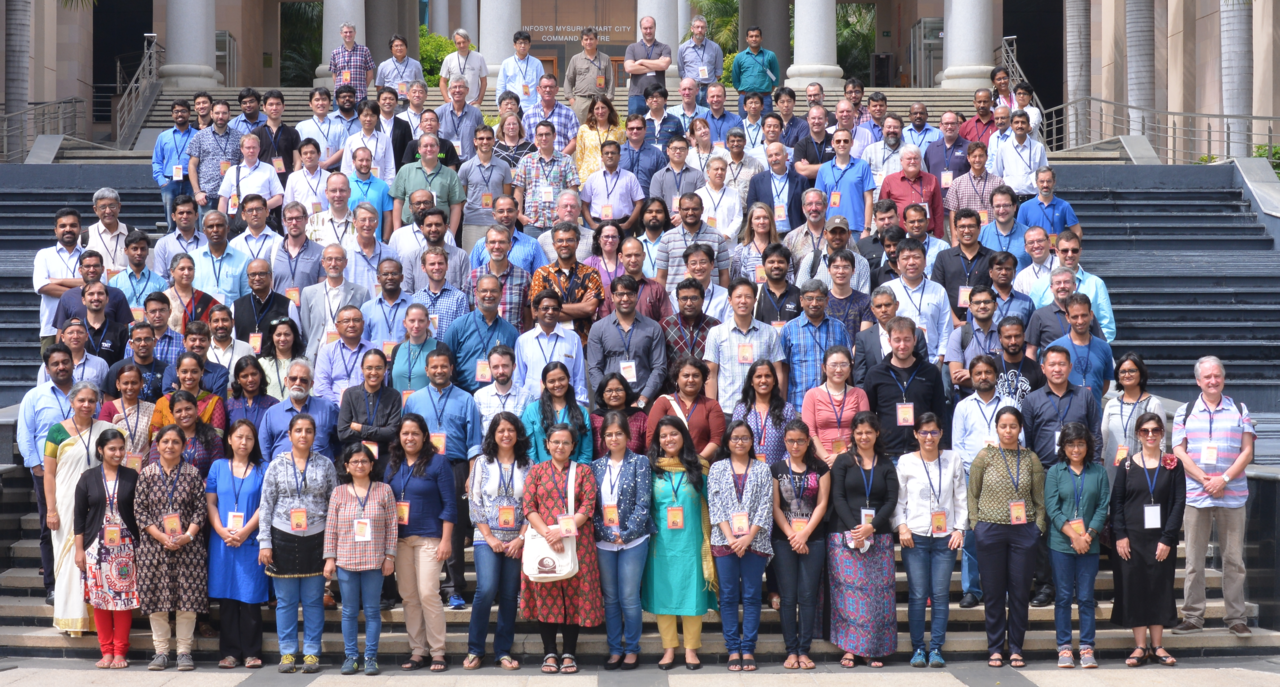
Group picture of TMT Science Forum participants, held at the campus of Infosys in Mysore, India - November 2017. Image Credit: Infosys / India TMT Coordination Center (ITCC)


Group picture of TMT Science Forum participants, held at the campus of Infosys in Mysore, India - November 2017. Image Credit: Infosys / India TMT Coordination Center (ITCC)
Pasadena, CA – March 9, 2018 – Future users of the Thirty Meter Telescope are now preparing studies of the science instruments that will be deployed after the telescope’s first-light instrumentation suite.
These instrument concept studies will deliver a series of White Papers for review by TMT’s Science Advisory Committee. The deadline is March 21, 2018 for receipt of these White Papers (see original Call for White Papers).
TMT’s first-light capabilities will include a near-infrared multi-conjugate adaptive optics (AO) system (NFIRAOS), the Infrared Imaging Spectrometer (IRIS), and the Wide-Field Optical Spectrometer (WFOS).
Building upon these initial TMT instruments, and upon the ground- and space-based facilities that will be operating throughout the next decade, the White Papers will address new scientific capabilities and priorities for TMT, such as: high dispersion optical and near-infrared spectroscopy; multiplexed medium-resolution near-infrared spectroscopy; ground-layer AO; extreme/high contrast AO and coronagraphy; and thermal infrared imaging and spectroscopy.
The fifth annual TMT Science Forum was held in Mysore, in south India. The Forum’s theme was “TMT: Beyond First Light”, and brought together more than 170 members of the international astronomical community of scientists, engineers and students from all of TMT’s project partner countries.
Meeting participants first engaged in a detailed review of the TMT project status. Building upon discussions started at the 2016 Forum in Japan, the 2017 Forum then focused on the main science questions to be answered by TMT’s next-generation instruments, and the new/future technologies that will address these questions. Parallel sessions were organized by the TMT International Science Development Teams (ISDTs) to brainstorm on instrument concepts beyond TMT first-light: high-resolution spectroscopy, high-contrast exoplanet imaging, multi-object spectrographs, thermal- and mid-Infrared astronomy, and time-domain science.
The 2017 Forum served as a springboard for science groups to initiate pre-conceptual studies for the next generation of TMT instruments, in response to the TMT Call for White Papers.
The Forum also provided an opportunity to share the experiences and lessons learned to date from the first-light IRIS and WFOS instrument teams.
Infosys hosted the three-day forum at its campus in Mysore, as well as a full day of instrument workshops that preceded it. A live webcast was also provided for members of the TMT science community worldwide.
While at the TMT Science Forum in Mysore, members of the TMT ISDTs received the “Research in Astronomy and Astrophysics Excellent Paper Award” for their contribution to the 2015 edition of the TMT Detailed Science Case.
The Detailed Science Case was developed by more than 150 astronomers from the TMT ISDTs and describes the broad and ambitious range of scientific aspirations of the future users of the TMT observatory. The 196-page document was published by “Research in Astronomy and Astrophysics” - http://www.raa-journal.org/raa/index.php/raa/article/view/2305 - an international journal publishing original research papers and reviews across all branches of astronomy and astrophysics.
Presentation of the Research in Astronomy and Astrophysics (RAA) award during TMT Science Forum -Nov. 7-9, 2017. Dr. Warren Skidmore and colleagues from TMT International Science Development Teams (ISDTs) receiving the award. Image Credit: Infosys / India TMT Coordination Center (ITCC)
TMT Observatory Software Infrastructure Progress
Thirty Meter Telescope’s Refrigeration Cooling System Passes Conceptual Design Review